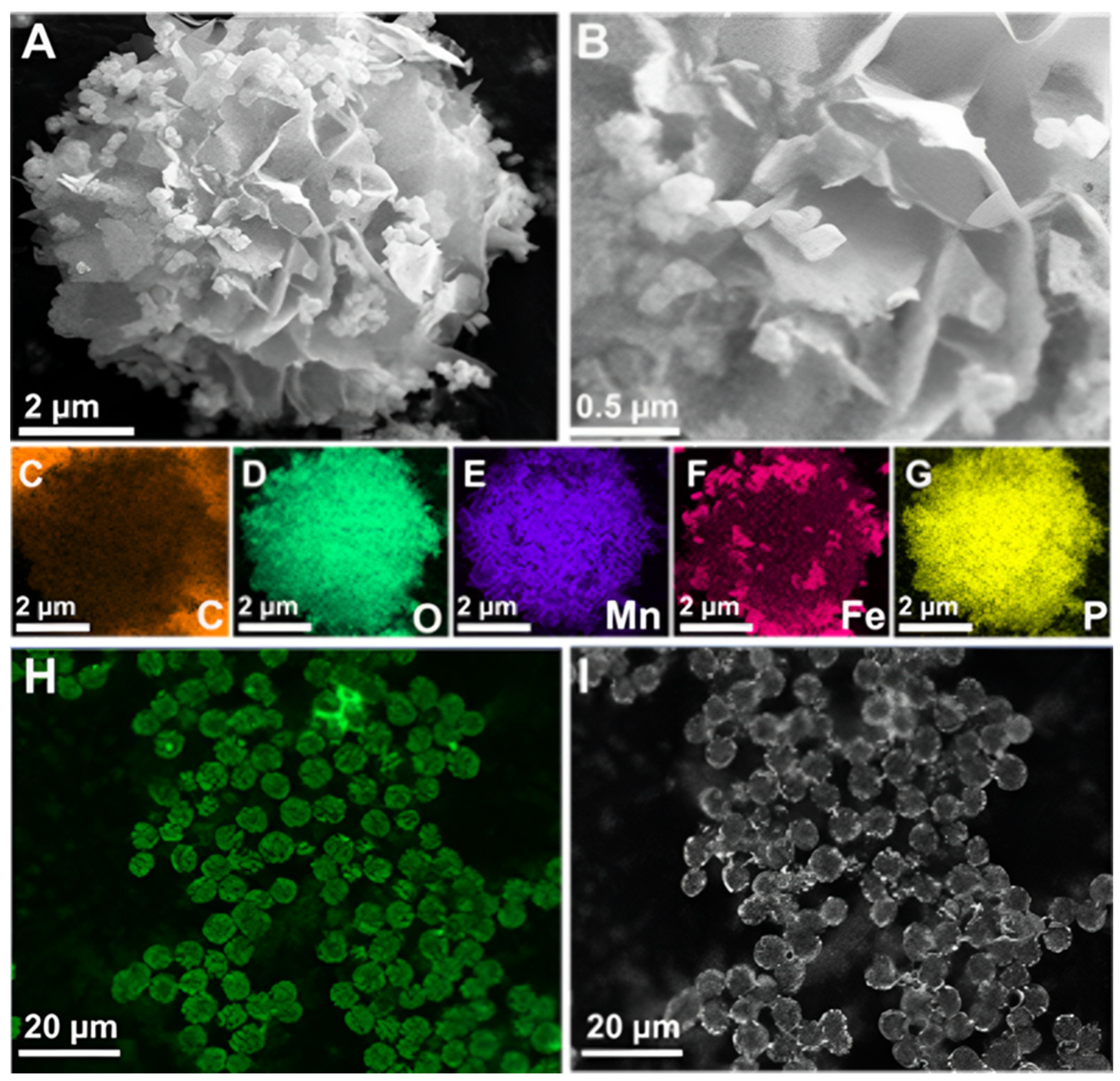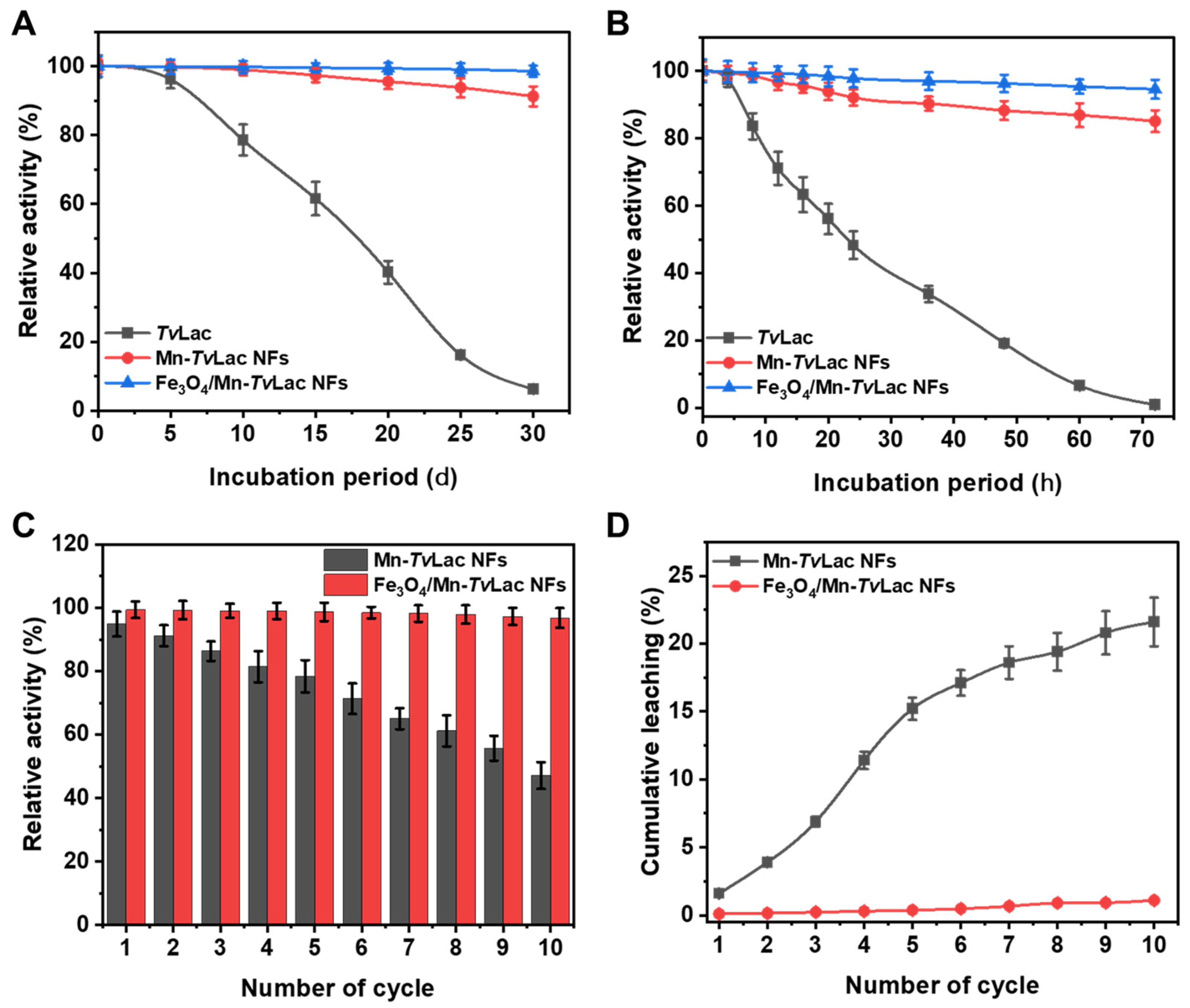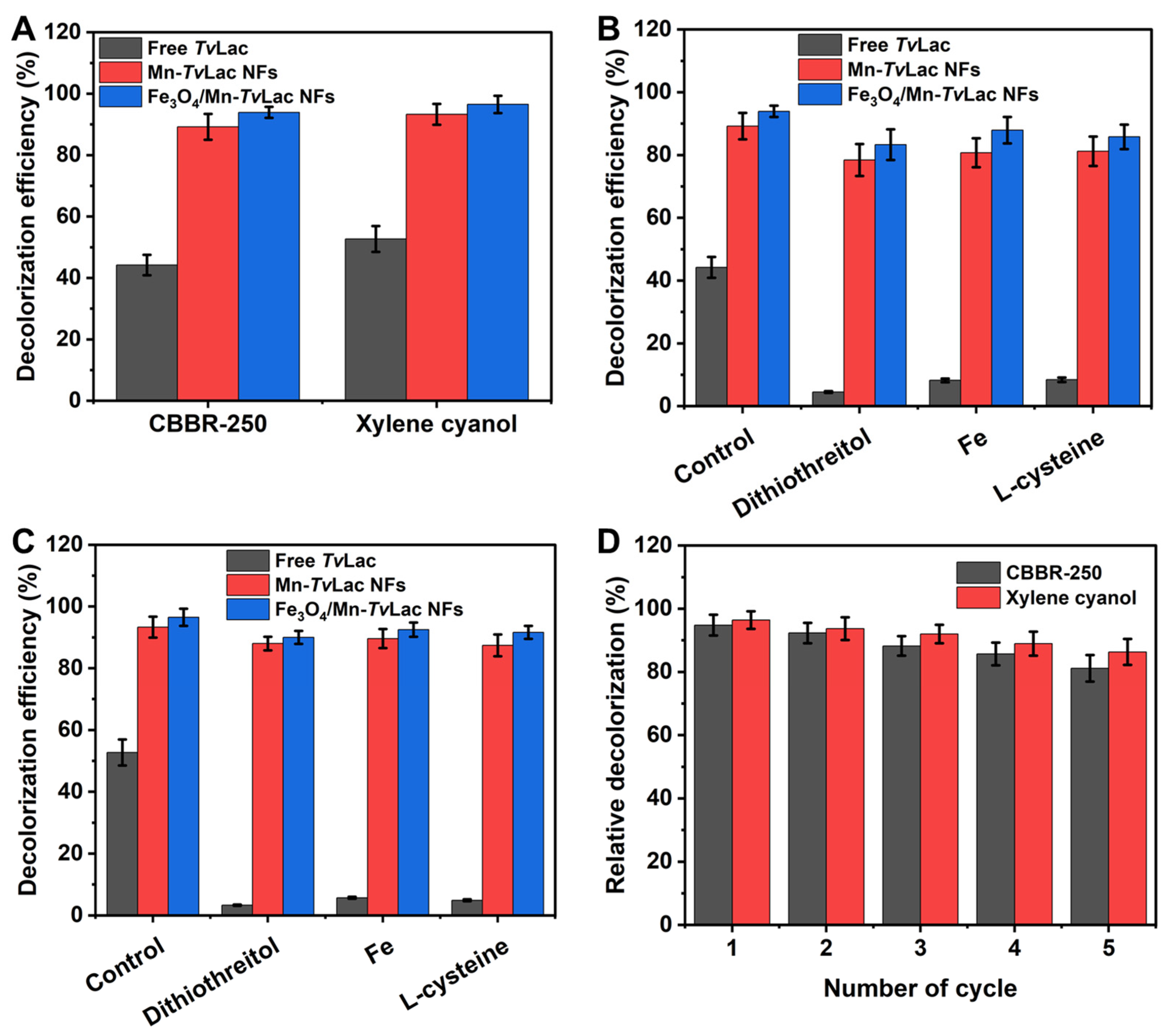Trametes versicolor Laccase-Based Magnetic Inorganic-Protein Hybrid Nanobiocatalyst for Efficient Decolorization of Dyes in the Presence of Inhibitors
Abstract
1. Introduction
2. Materials and Methods
2.1. Materials
2.2. Laccase Production and Partial Purification
2.3. Magnetic Nanoparticles and Laccase-Based Protein-Inorganic Hybrid Nanoflowers Synthesis
2.4. Laccase Activity Measurements
2.5. Characterization of Immobilized Laccase as Nanoflowers
2.6. Stability, Reusability, and Leaching Measurement
2.7. Acute Toxicity Analysis
2.8. Decolorization of Synthetic Dyes in the Presence of Laccase Inhibitors
2.9. Instrumental Measurements and Statistical Analysis
3. Results and Discussion
3.1. TvLac Production and Purification
3.2. Immobilization of TvLac Using Magnetic Nanoparticles and MnSO4 through Protein-Inorganic Hybrid Nanoflowers
3.3. Characterization of Free and Immobilized TvLac as Nanoflowers
3.4. Storage, Thermal Stability, Reusability, and Leaching
3.5. Acute Toxicity Analysis of Nanoflowers
3.6. Decolorization of Synthetic Dyes in the Presence of Inhibitors via Immobilized TvLac
4. Conclusions
Supplementary Materials
Author Contributions
Funding
Institutional Review Board Statement
Informed Consent Statement
Data Availability Statement
Conflicts of Interest
References
- Sheldon, R.A.; Woodley, J.M. Role of biocatalysis in sustainable chemistry. Chem. Rev. 2018, 118, 801–838. [Google Scholar] [CrossRef] [PubMed]
- Patel, S.K.S.; Gupta, R.K.; Kim, I.-W.; Lee, J.-K. Coriolus versicolor laccase-based inorganic protein hybrid synthesis for application in biomass saccharification to enhance biological production of hydrogen and ethanol. Enzym. Microb. Technol. 2023, 170, 110301. [Google Scholar] [CrossRef] [PubMed]
- Zhu, C.-Y.; Li, F.-L.; Zhang, Y.-W.; Gupta, R.K.; Patel, S.K.S.; Lee, J.-K. Recent strategies for the immobilization of therapeutic enzymes. Polymers 2022, 14, 1409. [Google Scholar] [CrossRef] [PubMed]
- Nezhad, N.G.; Rahman, R.N.Z.R.A.; Normi, Y.M.; Oslan, S.N.; Shariff, F.M.; Leow, T.C. Recent advances in the simultaneous thermostability-activity improvement of industrial enzymes through structure modification. Int. J. Biol. Macromol. 2023, 232, 123440. [Google Scholar] [CrossRef]
- Patel, H.; Upadhyay, R.V.; Parekh, K.; Reis, D.; Oliveira, C.L.P.; Neto, A.M.F. Optimized Mn0.5Zn0.5Fe2O4 nanoflowers based magnetic fluids for potential biomedical applications. J. Magn. Magn. Mater. 2024, 590, 171656. [Google Scholar] [CrossRef]
- Anwar, A.; Imran, M.; Iqbal, H.M.N. Smart chemistry and applied perceptions of enzyme-coupled nano-engineered assemblies to meet future biocatalytic challenges. Coord. Chem. Rev. 2023, 493, 215329. [Google Scholar] [CrossRef]
- Mohidem, N.A.; Mohamad, M.; Rashid, M.U.; Norizan, M.N.; Hamzah, F.; Mat, H.B. Recent advances in enzyme immobilisation strategies: An overview of techniques and composite carriers. J. Compos. Sci. 2023, 7, 488. [Google Scholar] [CrossRef]
- Lee, I.; Cheon, H.J.; Adhikari, M.D.; Tran, T.D.; Yeon, K.-M.; Kim, M.I.; Kim, J. Glucose oxidase-copper hybrid nanoflowers embedded with magnetic nanoparticles as an effective antibacterial agent. Int. J. Biol. Macromol. 2020, 155, 1520–1531. [Google Scholar] [CrossRef] [PubMed]
- Jafari-Nodoushan, H.; Mojtabavi, S.; Faramarzi; Samadi, N. Organic-inorganic hybrid nanoflowers: The known, the unknown, and the future. Adv. Colloid Interface Sci. 2022, 309, 102780. [Google Scholar] [CrossRef] [PubMed]
- Lee, H.R.; Chun, M.; Kim, M.I.; Ha, S.H. Preparation of glutaraldehyde-treated lipaseinorganic hybrid nanoflowers and their catalytic performance as immobilized enzymes. Enzym. Microb. Technol. 2017, 105, 24–29. [Google Scholar] [CrossRef] [PubMed]
- Patil, P.D.; Kelkar, R.K.; Patil, N.P.; Pise, P.V.; Patil, S.P.; Patil, A.S.; Kulkarni, N.S.; Tiwari, M.S.; Phirke, A.N.; Nadar, S.S. Magnetic nanoflowers: A hybrid platform for enzyme immobilization. Crit. Rev. Biotechnol. 2023. [Google Scholar] [CrossRef] [PubMed]
- Bilal, M.; Asgher, M.; Shah, S.Z.H.; Iqbal, H.M.N. Engineering enzyme-coupled hybrid nanoflowers: The quest for optimum performance to meet biocatalytic challenges and opportunities. Int. J. Biol. Macromol. 2019, 135, 677–690. [Google Scholar] [CrossRef] [PubMed]
- Maghraby, Y.R.; El-Shabasy, R.M.; Ibrahim, A.H.; Azzazy, H.M.E. Enzyme immobilization technologies and industrial applications. ACS Omega 2023, 8, 5184–5196. [Google Scholar] [CrossRef] [PubMed]
- Weng, Y.; Chen, R.; Hui, Y.; Chen, D.; Zhao, C.-X. Boosting enzyme activity in enzyme metal–organic framework composites. Chem. Bio. Eng. 2024, 1, 99–112. [Google Scholar] [CrossRef] [PubMed]
- Li, Y.; Wu, H.; Su, Z. Enzyme-based hybrid nanoflowers with high performances for biocatalytic, biomedical, and environmental applications. Coord. Chem. Rev. 2020, 416, 213342. [Google Scholar] [CrossRef]
- Zhang, M.; Zhang, Y.; Yang, C.; Ma, C.; Tang, J. Enzyme-inorganic hybrid nanoflowers: Classification, synthesis, functionalization and potential applications. Chem. Eng. J. 2021, 415, 129075. [Google Scholar] [CrossRef]
- Ge, J.; Lei, J.; Zare, R.N. Protein-inorganic hybrid nanoflowers. Nat. Nanotechnol. 2012, 7, 428–432. [Google Scholar] [CrossRef] [PubMed]
- Da Costa, F.P.; Cipolatti, E.P.; Junior, A.F.; Henriques, R.O. Nanoflowers: A new approach of enzyme immobilization. Chem. Rec. 2022, 22, e202100293. [Google Scholar] [CrossRef] [PubMed]
- Fu, M.; Xing, J.; Ge, Z. Preparation of laccase-loaded magnetic nanoflowers and their recycling for efficient degradation of bisphenol A. Sci. Total Environ. 2019, 651, 2857–2865. [Google Scholar] [CrossRef] [PubMed]
- Mohammad, M.; Ahmadpoor, F.; Shojaosadati, S.A. Mussel-inspired magnetic nanoflowers as an effective nanozyme and antimicrobial agent for biosensing and catalytic reduction of organic dyes. ACS Omega 2020, 5, 18766–18777. [Google Scholar] [CrossRef] [PubMed]
- Han, J.; Luo, P.; Wang, L.; Li, C.; Mao, Y.; Wang, Y. Construction of magnetic nanoflower biocatalytic system with enhanced enzymatic performance by biomineralization and its application for bisphenol A removal. J. Hazard. Mater. 2019, 380, 120901. [Google Scholar] [CrossRef] [PubMed]
- Zhong, L.; Jiao, X.; Hu, H.; Shen, X.; Zhao, J.; Feng, Y.; Li, C.; Du, Y.; Cui, J.; Jia, S. Activated magnetic lipase-inorganic hybrid nanoflowers: A highly active and recyclable nanobiocatalyst for biodiesel production. Renew. Energy 2021, 171, 825–832. [Google Scholar] [CrossRef]
- Patel, S.K.S.; Anwar, M.Z.; Kumar, A.K.; Otari, S.V.; Pagolu, R.T.; Kim, S.-Y.; Kim, I.-W.; Lee, J.-K. Fe2O3 yolk-shell particle-based laccase biosensor for efficient detection of 2,6-dimethoxyphenol. Biochem. Eng. J. 2018, 132, 1–8. [Google Scholar] [CrossRef]
- Shraddha, X.; Shekher, R.; Sehgal, S.; Kamthania, M.; Kumar, A. Laccase: Microbial sources, production, purification, and potential biotechnological applications. Enzym. Res. 2011, 2011, 217861. [Google Scholar] [CrossRef] [PubMed]
- Chaudhary, S.; Varma, A.; Jha, S.; Patel, S.K.S.; Porwal, S. Production, purification, and characterization of recombinant Bhargavaea beijingensis laccase for potential lignin degradation and dyes decolorization. Catal. Lett. 2024, 154, 1537–1546. [Google Scholar] [CrossRef]
- Chen, Z.; Oh, W.-D.; Yap, P.-S. Recent advances in the utilization of immobilized laccase for the degradation of phenolic compounds in aqueous solutions: A review. Chemosphere 2022, 307, 135824. [Google Scholar] [CrossRef] [PubMed]
- Pinheiro, B.B.; Saibi, S.; Haroune, L.; Rios, N.S.; Gonçalves, L.R.B.; Cabana, H. Genipin and glutaraldehyde based laccase two-layers immobilization with improved properties: New biocatalysts with high potential for enzymatic removal of trace organic contaminants. Enzym. Microb. Technol. 2023, 169, 110261. [Google Scholar] [CrossRef] [PubMed]
- Morsy, S.A.G.Z.; Tajudin, A.A.; Ali, M.S.M.; Shariff, F.M. Current development in decolorization of synthetic dyes by immobilized laccases. Front. Microbiol. 2020, 11, 572309. [Google Scholar] [CrossRef] [PubMed]
- Peñaranda, P.A.; Noguera, M.J.; Florez, S.L.; Husserl, J.; Ornelas-Soto, N.; Cruz, J.C.; Osma, J.F. Treatment of wastewater, phenols and dyes using novel magnetic torus microreactors and laccase immobilized on magnetite nanoparticles. Nanomaterials 2022, 12, 1688. [Google Scholar] [CrossRef] [PubMed]
- Li, H.; Hou, J.; Duan, L.; Ji, C.; Zhang, Y.; Chen, V. Graphene oxide-enzyme hybrid nanoflowers for efficient water soluble dye removal. J. Hazard. Mater. 2017, 445, 93–101. [Google Scholar] [CrossRef] [PubMed]
- Suman, S.K.; Malhotra, M.; Kurmi, A.A.; Narani, A.; Bhaskar, T.; Ghosh, S.; Jain, S.L. Jute sticks biomass delignification through laccase-mediator system for enhanced saccharification and sustainable release of fermentable sugar. Chemosphere 2022, 286, 131687. [Google Scholar] [CrossRef] [PubMed]
- Wang, Y.; Zhang, X.; Lu, C.; Li, X.; Zhou, J.; Wang, J. Lanthanum: A novel inducer for enhancement of fungal laccase production by Shiraia bambusicola. J. Rare Earth 2022, 40, 508–516. [Google Scholar] [CrossRef]
- Cheon, H.J.; Adhikari, M.D.; Chung, M.; Tran, T.D.; Kim, J.; Kim, M.I. Magnetic nanoparticles-embedded enzyme-inorganic hybrid nanoflowers with enhanced peroxidase-like activity and substrate channeling for glucose biosensing. Adv. Healthc. Mater. 2019, 8, 1801507. [Google Scholar] [CrossRef] [PubMed]
- Bradford, M.M. A rapid and sensitive method for the quantitation of microgram quantities of protein utilizing the principle of protein-dye binding. Anal. Biochem. 1976, 72, 248–254. [Google Scholar] [CrossRef] [PubMed]
- Patel, S.K.S.; Otari, S.V.; Kang, Y.C.; Lee, J.-K. Protein–inorganic hybrid system for efficient histagged enzymes immobilization and its application in L-xylulose production. RSC Adv. 2017, 7, 3488–3494. [Google Scholar] [CrossRef]
- Patel, S.K.S.; Otari, S.V.; Li, J.; Kim, D.R.; Kim, S.C.; Cho, B.K.; Kalia, V.C.; Kang, Y.C.; Lee, J.-K. Synthesis of cross-linked protein-metal hybrid nanoflowers and its application in repeated batch decolorization of synthetic dyes. J. Hazard. Mater. 2018, 347, 442–450. [Google Scholar] [CrossRef] [PubMed]
- Patel, S.K.S.; Kalia, V.V.; Lee, J.-K. Laccase immobilization on copper-magnetic nanoparticles for efficient bisphenol degradation. J. Microbiol. Biotechnol. 2023, 33, 127–134. [Google Scholar] [CrossRef] [PubMed]
- Cen, Q.; Wu, X.; Cao, L.; Lu, Y.; Lu, X.; Chen, J.; Fu, G.; Liu, Y.; Ruan, R. Green production of a yellow laccase by Coriolopsis gallica for phenolic pollutants removal. AMB Express 2022, 12, 96. [Google Scholar] [CrossRef] [PubMed]
- Vojdanitalab, K.; Jafari-Nodoushan, H.; Mojtabavi, S.; Shokri, M.; Jahandar, H.; Faramarzi, M. Instantaneous synthesis and full characterization of organic–inorganic laccase-cobalt phosphate hybrid nanoflowers. Sci. Rep. 2022, 12, 9297. [Google Scholar] [CrossRef] [PubMed]
- Jafari-Nodoushan, H.; Fazeli, M.R.; Faramarzi, M.A.; Samadi, N. Hierarchically-structured laccase@Ni3(PO4)2 hybrid nanoflowers for antibiotic degradation: Application in real wastewater effluent and toxicity evaluation. Int. J. Biol. Macromol. 2023, 234, 123574. [Google Scholar] [CrossRef]
- Al-Maqdi, K.A.; Elmerhi, N.; Alzamly, A.; Shah, I.; Ashraf, S.S. Laccase–copper phosphate hybrid nanoflower as potent thiazole remediation agent. J. Water Process Eng. 2023, 51, 103438. [Google Scholar] [CrossRef]
- Kiani, M.; Mojtabavi, S.; Jafari-Nodoushan, H.; Tabib, S.R.; Hassannejad, N.; Faramarzi, M.A. Fast anisotropic growth of the biomineralized zinc phosphate nanocrystals for a facile and instant construction of laccase@Zn3(PO4)2 hybrid nanoflowers. Int. J. Biol. Macromol. 2022, 204, 520–531. [Google Scholar] [CrossRef] [PubMed]
- Zhang, Z.; Zhang, Y.; Song, R.; Wang, M.; Yan, F.; He, L.; Feng, X.; Fang, S.; Zhao, J.; Zhang, H. Manganese(II) phosphate nanoflowers as electrochemical biosensors for the high-sensitivity detection of ractopamine. Sens. Actuators B Chem. 2015, 211, 310–317. [Google Scholar] [CrossRef]
- Rai, S.K.; Narnoliya, L.K.; Sangwan, R.S.; Yadav, S.K. Self-assembled hybrid nanoflowers of manganese phosphate and L-arabinose isomerase: A stable and recyclable nanobiocatalyst for equilibrium level conversion of D-galactose to D-tagatose. ACS Sustain. Chem. Eng. 2018, 6, 6296–6304. [Google Scholar] [CrossRef]
- Zhang, M.; Zhang, Y.; Yang, C.; Ma, C.; Zhang, Y.; Tang, J. Facile synthesis of recyclable laccase-mineral hybrid complexes with enhanced activity and stability for biodegradation of Evans Blue dye. Int. J. Biol. Macromol. 2021, 188, 783–789. [Google Scholar] [CrossRef] [PubMed]
- Sun, H.; Yuan, F.; Jia, S.; Zhang, X.; Xing, W. Laccase encapsulation immobilized in mesoporous ZIF-8 for enhancement bisphenol A degradation. J. Hazard. Mater. 2023, 445, 130460. [Google Scholar] [CrossRef] [PubMed]
- Rezayaraghi, F.; Jafari-Nodoushan, H.; Mojtabavi, S.; Golshani, S.; Jahandar, H.; Faramarzi, M.A. Hybridization of laccase with dendrimer-grafted silica-coated hercynite-copper phosphate magnetic hybrid nanoflowers and its application in bioremoval of Gemifloxacin. Environ. Sci. Pollut. Res. 2022, 29, 89255–89272. [Google Scholar] [CrossRef] [PubMed]
- Han, Z.; Wang, H.; Zheng, J.; Wang, S.; Yu, S.; Lu, L. Ultrafast synthesis of laccase copper phosphate hybrid nanoflowers for efficient degradation of tetracycline antibiotics. Environ. Res. 2023, 216, 114690. [Google Scholar] [CrossRef] [PubMed]
- Bîtcan, I.; Petrovici, A.; Pellis, A.; Klebertc, S.; Karolyc, Z.; Bereczkic, L.; Peter, F.; Todea, A. Enzymatic route for selective glycerol oxidation using covalently immobilized laccases. Enzym. Microb. Technol. 2023, 163, 110168. [Google Scholar] [CrossRef] [PubMed]
- Chen, F.; Wu, L.; Xiao, X.; Rong, L.; Li, M.; Zou, X. Mixture toxicity of zinc oxide nanoparticle and chemicals with different mode of action upon Vibrio fischeri. Environ. Sci. Eur. 2020, 32, 41. [Google Scholar] [CrossRef]
- Ledda, C.; Rapisarda, V.; Bracci, M.; Proietti, L.; Zuccarello, M.; Fallico, R.; Fiore, M.; Ferrante, M. Professional exposure to basaltic rock dust: Assessment by the Vibrio fischeri ecotoxicological test. J. Occup. Med. Toxicol. 2013, 8, 23. [Google Scholar] [CrossRef] [PubMed]
- Garcia, A.; Espinosa, R.; Delgado, L.; Casals, E.; Gonzalez, E.; Puntes, V.; Barata, C.; Font, X.; Sanchez, A. Acute toxicity of cerium oxide, titanium oxide and iron oxide nanoparticles using standardized tests. Desalination 2011, 269, 136–141. [Google Scholar] [CrossRef]
- Forootanfar, H.; Moezzi, A.; Aghaie-Khozani, M.; Mahmoudjanlou, Y.; Ameri, A.; Niknejad, F.; Faramarzi, M.A. Synthetic dye decolorization by three sources of fungal laccase. Iran. J. Environ. Health Sci. Eng. 2012, 9, 27. [Google Scholar] [CrossRef] [PubMed]
- Salami, F.; Habibi, Z.; Yousefi, M.; Mohammadi, M. Covalent immobilization of laccase by one pot three component reaction and its application in the decolorization of textile dyes. Int. J. Biol. Macromol. 2018, 120, 144–151. [Google Scholar] [CrossRef] [PubMed]
- Lan, J.; Huang, X.; Hu, M.; Li, Y.; Qu, Y.; Gao, P.; Wu, D. High efficient degradation of dyes with lignin peroxidase coupled with glucose oxidase. J. Biotechnol. 2006, 123, 483–490. [Google Scholar] [CrossRef] [PubMed]
- Zheng, F.; Cui, B.-K.; Wu, X.-J.; Meng, G.; Liu, H.-X.; Si, J. Immobilization of laccase onto chitosan beads to enhance its capability to degrade synthetic dyes. Int. Biodeterior. Biodegrad. 2016, 110, 69–78. [Google Scholar] [CrossRef]
- Li, S.; Liu, Q.; Liu, J.; Sun, K.; Yang, W.; Si, Y.; Li, Y.; Gao, Y. Inhibition mechanisms of Fe2+/Fe3+ and Mn2+ on fungal laccase-enabled bisphenol a polyreaction. Chemosphere 2022, 307, 135685. [Google Scholar] [CrossRef] [PubMed]
- Bayraktaroğlu, M.; Husein, I.; Uygun, A.D.; Uygun, M. Lectin-modified cryogels for laccase immobilization: A decolorization study. Water Air Soil Pollut. 2020, 231, 31. [Google Scholar] [CrossRef]





| Hybrids | Encapsulation Yield (%) | Relative Activity (%) a |
|---|---|---|
| Mn-TvLac | 90.3 ± 2.2 | 260 ± 18.4 |
| Fe3O4/Mn-TvLac | 85.5 ± 3.6 | 245 ± 14.7 |
| Enzyme | Vmax (µmol min−1 mg Protein−1) | Km (µM) |
|---|---|---|
| Free TvLac | 219 ± 14.6 | 38.1 ± 2.4 |
| Mn-TvLac NFs | 570 ± 37.8 | 17.1 ± 1.2 |
| Fe3O4/Mn-TvLac NFs | 542 ± 33.2 | 17.6 ± 1.3 |
| Temperature (°C) | Free TvLac | Mn-TvLac NFs | Fe3O4/Mn-TvLac NFs | |||
|---|---|---|---|---|---|---|
| kd (h−1) | t1/2 (h) | kd (h−1) | t1/2 (h) | kd (h−1) | t1/2 (h) | |
| 40 | 0.057 ± 0.005 | 12.2 ± 0.9 | 0.027 ± 0.002 | 25.6 ± 1.6 | 0.023 ± 0.002 | 30.5 ± 2.4 |
| 45 | 0.076 ± 0.006 | 9.12 ± 0.6 | 0.038 ± 0.003 | 18.3 ± 1.4 | 0.026 ± 0.002 | 26.4 ± 1.9 |
| 50 | 0.112 ± 0.009 | 6.21 ± 0.3 | 0.049 ± 0.004 | 14.1 ± 1.1 | 0.033 ± 0.003 | 21.1 ± 1.7 |
| 60 | 0.173 ± 0.014 | 4.03 ± 0.2 | 0.058 ± 0.005 | 11.9 ± 0.9 | 0.040 ± 0.003 | 17.2 ± 1.2 |
| 70 | 0.770 ± 0.051 | 0.90 ± 0.1 | 0.182 ± 0.015 | 3.80 ± 0.3 | 0.090 ± 0.007 | 7.71 ± 0.6 |
| Particles | EC50 a Concentration (µg mL−1) |
|---|---|
| Fe3O4 nanoparticles | 325 ± 30 |
| Mn-TvLac NFs | 695 ± 55 |
| Fe3O4/Mn-TvLac NFs | 980 ± 73 |
Disclaimer/Publisher’s Note: The statements, opinions and data contained in all publications are solely those of the individual author(s) and contributor(s) and not of MDPI and/or the editor(s). MDPI and/or the editor(s) disclaim responsibility for any injury to people or property resulting from any ideas, methods, instructions or products referred to in the content. |
© 2024 by the authors. Licensee MDPI, Basel, Switzerland. This article is an open access article distributed under the terms and conditions of the Creative Commons Attribution (CC BY) license (https://creativecommons.org/licenses/by/4.0/).
Share and Cite
Patel, S.K.S.; Gupta, R.K.; Karuppanan, K.K.; Padhi, D.K.; Ranganathan, S.; Paramanantham, P.; Lee, J.-K. Trametes versicolor Laccase-Based Magnetic Inorganic-Protein Hybrid Nanobiocatalyst for Efficient Decolorization of Dyes in the Presence of Inhibitors. Materials 2024, 17, 1790. https://doi.org/10.3390/ma17081790
Patel SKS, Gupta RK, Karuppanan KK, Padhi DK, Ranganathan S, Paramanantham P, Lee J-K. Trametes versicolor Laccase-Based Magnetic Inorganic-Protein Hybrid Nanobiocatalyst for Efficient Decolorization of Dyes in the Presence of Inhibitors. Materials. 2024; 17(8):1790. https://doi.org/10.3390/ma17081790
Chicago/Turabian StylePatel, Sanjay K. S., Rahul K. Gupta, Karthikeyan K. Karuppanan, Deepak K. Padhi, Sampathkumar Ranganathan, Parasuraman Paramanantham, and Jung-Kul Lee. 2024. "Trametes versicolor Laccase-Based Magnetic Inorganic-Protein Hybrid Nanobiocatalyst for Efficient Decolorization of Dyes in the Presence of Inhibitors" Materials 17, no. 8: 1790. https://doi.org/10.3390/ma17081790
APA StylePatel, S. K. S., Gupta, R. K., Karuppanan, K. K., Padhi, D. K., Ranganathan, S., Paramanantham, P., & Lee, J.-K. (2024). Trametes versicolor Laccase-Based Magnetic Inorganic-Protein Hybrid Nanobiocatalyst for Efficient Decolorization of Dyes in the Presence of Inhibitors. Materials, 17(8), 1790. https://doi.org/10.3390/ma17081790











